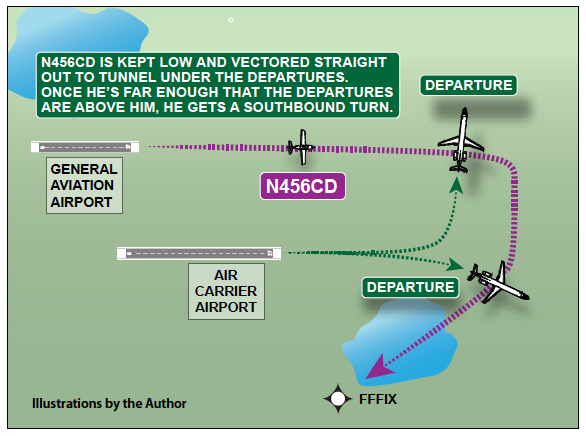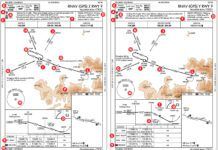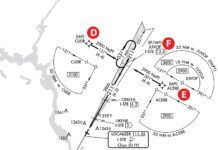The rumble of tire rubber on asphalt suddenly ceases. Runway 9 falls away as you climb straight ahead, assigned runway heading up to 3000 feet. Your requested cruising altitude is 9000. “Contact Departure,” Tower says.
Your next fix—FFFIX—is a right turn to the southeast. But in that direction lies a large air-carrier airport. Airliner departures are lining up for their Runway 9, and you catch the sparkle of other jets on their downwind. The magenta line on your GPS slices right through all that.
I’m working Departure when you check in. I know where you want to go. I also know what’s going on at the airliner airport. So, “Cleared direct” isn’t happening for you right now. It’s time to get creative. Which options are on the table, and what’s the deciding factor in picking one?
Watcha Driving?
Our air traffic control decision-making process requires analyzing traffic and weather conditions. As each aircraft enters my airspace, I must be familiar with their requested routing and altitude, and any special requests. However, the type of aircraft you’re flying is the key factor that decides how we accommodate those requests.
I’m an unabashed airplane geek. I love learning about aircraft and as much aviation history as I can. There are many other controllers whose interests lie elsewhere. They won’t nerd out watching an afterburning F-35 leap off the runway or hear the sound of a P-51 Mustang’s Merlin engine. It doesn’t mean they aren’t good controllers; it’s just not their thing.
Regardless of our individual aviation enthusiasm levels, all controllers are trained and encouraged to be familiar with as many aircraft types as possible. While sequencing and vectoring, we must account for both their expected speeds and climb/descent rates.
In this month’s edition of “Captain Obvious Says….” jets generally fly fast, piston-engine planes fly slow, and turboprops fall somewhere between. Even a “fast” piston like a Cirrus SR22 is far closer in performance to a Cessna 172 than it is to a Gulfstream IV, or even a Beechcraft King Air.
Like the ground below, these performance limitations are immutable. I can’t demand the impossible, like assigning 250 knots to a Piper Cherokee. The choices get narrowed significantly by what you’re flying.
Tunneling Under
Imagine you’re flying a Cessna 172 Skyhawk. These are great, sturdy airplanes, but, uh, leisurely in terms of performance. If I turned you southeast, your lower climb rate and speed would drive you right in the way of my airliner departures, which are climbing high and going in all directions.
This is where I mention that part of my job description includes the word “expeditious” (after “safe” and “orderly”). While I could legally tell the airliner airport’s tower to “stop departures” and hold all the big jets filled with many hundreds of passengers on the ground just so you can go direct, that wouldn’t be very efficient or expeditious.
So, one option is to leave you flying straight out and keep you at a low altitude— 3000 feet, in this case. I would also ensure the tower doesn’t turn any jets left. Now, both you and the airliners will parallel each other. Once they climb above you, I can turn them north.
That’s safe, and the airliners aren’t severely impacted. So, what’s the drawback? You’re going to be on that runway heading awhile. Some jets aren’t out of 4000 until they’re out of 10 or 15 miles away from the airport, so you’ll need to fly at least that far before I can start working you towards the south. Even then, you’ll likely need to stay low.
All told, you could wind up flying an extra 20-30 miles until you’re in a good spot and get climbing. Are there any options that are easier on the Hobbs meter? Let’s see what we’ve got.
Hard to Starboard
Instead of straight out, how about a hard right turn to the southwest? This will allow you to pass west of the airliner airport, leaving their departure corridor unencumbered. Once you’ve passed that airport, I can turn you to the southeast.
Sounds good, right? Well, departures are only one part of the equation. I must also consider arrivals, both those on final and on the downwind. My biggest concern here is everyone’s altitude.
Since you’ll be passing over the final for Runway 9, you need to be high enough so that, if one of the airliners goes around—which does happen—he won’t climb into you. Our standard missed approach altitude is 2000, so you need to be at 3000 by the time you’re near the final. (We’re required to have 1000 feet of vertical separation between IFR aircraft.)
A Skyhawk may not be able to make the necessary climb. No matter how often I plead, “Expedite climb,” that won’t change. So, let’s put you in a Cirrus SR22 instead, which has a better climb rate. Now you’re topping the final just fine. One hurdle is surmounted.
However, we’ve still got the downwind puzzle. Our arrivals descend to 5000 on the downwind. A Cirrus might climb better, but you still won’t be out of 6000 by the time you approach the downwind. I can’t guarantee vertical separation. I don’t want to put myself in a situation where you’re climbing to 9000, jets are dropping to 5000, and now I have to watch it closely.
Instead, I’ll simply assign you 4000 feet. You get a little climb and the jets get properly setup on the downwind. Once you’re south of the downwind, I can climb you and turn you on course.
Wraparound
So far, our performance leaps have taken us from a Skyhawk to a Cirrus. Let’s go for broke, get you a type rating, and put you in a jet. Now you’re departing in a Cessna Citation X, one of the fastest civilian jets ever made. How will that change my plan for you?
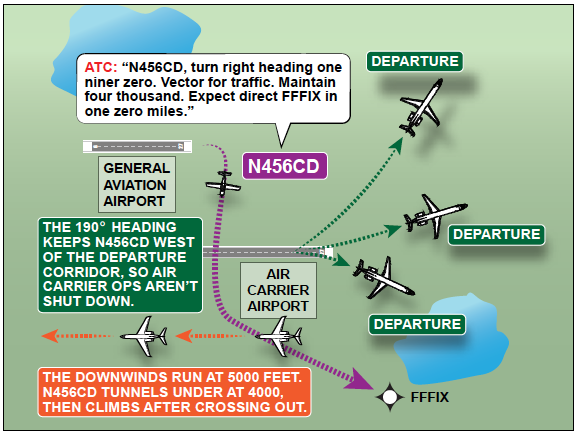
ATC’s main goal with jets is to keep them climbing. If I leave you straight out, eastbound, I can climb you, but you and my northbound airliner departures may block each other from turning. If I turn you hard right, you might still conflict with my downwind. I could still have to stop you at 4000. That’s safe, sure, but not efficient.
What can I do? Well, how about a left turn? “Turn left—I say again—turn left, heading 270. Climb and maintain 9000.” That’ll take care of it.
“Hold on,” you may be thinking, “isn’t that the exact opposite direction of where I want to go?” Sure is. But here’s the trick: I’m aiming for altitude separation. And I’m also betting, given that you’re a jet, you’re going to climb pretty quickly.
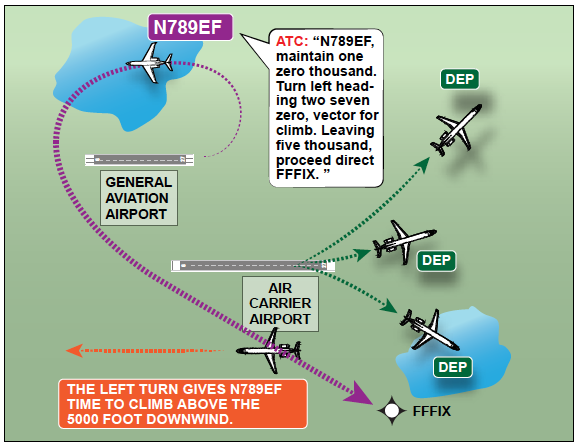
As you make that left turn, I’m watching your altitude increase. If you’re climbing really well, you’ll likely never even roll out on the 270 heading. I’ll just tell you, “Continue left turn, proceed direct FFFIX.” You’ll just keep hooking left until you line up on the fix.
If I don’t want to watch your climb rate that closely, I can just make your southbound turn conditional. “Leaving 5000, turn left direct FFFIX.” That guarantees you won’t turn towards FFFIX until you’re above my 5000 foot downwind. You only had to fly a few miles out of your way, and the end result is nice and clean and safe.
Years ago, I was trying to get home after a long work day. The traffic was even worse than usual, six miles of bumper-to-bumper nonsense. Was a major accident slowing everything down? Nope. There was just a random guy walking along the side of the highway, and people were slowing down to gawk and avoid him.
One dude strolling where he wasn’t supposed to be caused a major distraction and inconvenience for everyone. That kind of traffic jam can happen in the air too. If ATC lets a slow-moving IFR airplane get into a crappy spot, life becomes extremely difficult.
I was in the radar room one day, watching a trainee deal with some weather in the area. Half of our airspace was covered by moderate and heavy precipitation. This meant all of our jet arrivals and jet departures were climbing, descending, and crossing out in one area. For the same reason you don’t install a toilet in your kitchen, having things going in and out in the same place really, uh, stinks.
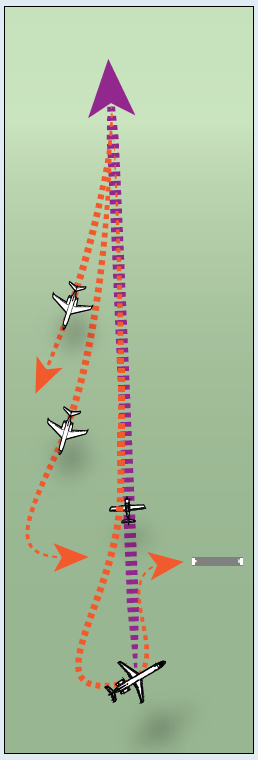
In the middle of this maelstrom was a Cessna Skyhawk overflight plugging along at 6000 feet. His route had him head-on to all our arrivals, right where the arrivals were supposed to be descending out of 10,000 for 3000 feet. Departures were also climbing off our airports and deviating unpredictably. That’s not a good combo.
First, let me describe what should have happened. The trainee should’ve vectored the Cessna left. An offset of a mere five or ten miles would’ve opened a clear path for everyone else. It wouldn’t be a big deal for the Cessna. Alas, it was not to be.
Instead of one little vector for one little airplane, the trainee let this IFR Cessna truck into the thick of things. The Skyhawk driver was happy. Everyone else got shafted. The trainee wound up with one arriving airliner stuck on top of the Cessna, at 7000 feet, on a ten mile final—way too high, of course—who had to be vectored back around to get down. Following that, arrivals needed to be vectored well out of their way until they could tunnel under the Cessna. Complicating things, some deviating departures got held down to 5000 until they passed the Cessna.
It was a real kerfuffle, a perfect illustration of how one bad choice can grossly increase ATC workload. That trainee learned a lesson: put airplanes in good spots, or it’s going to hurt everyone involved. —TK
The Unknown Lands
You’re now leveling off at 9000, and have departed FFFIX, flying southeast— about a 120 heading—towards your next waypoint. I hand you off to Center. Somewhere, a hundred miles away from me, your target starts flashing on a Center controller’s scope.
I know my airspace and how its traffic flows. I’ve had years of training and experience on our procedures and geography. But, I know very little of what goes on beyond my facility’s boundary.
Suddenly, I get a call on the landline from the Center. When I answer, they ask me, “Request N456CD on a heading of 050.” He must have something going on. Believe it or not, controllers aren’t in the business of pulling aircraft off routes for their own amusement.
I acknowledge Center’s request and give them control to turn you back on course whenever they’re ready to do so. To you, I say, “N456CD, Center request: Fly heading 050.” You make the turn. I switch you to Center.
Meanwhile, I’m scanning for targets. Sure enough, I see some targets descending rapidly out of the flight levels in Center’s airspace, headed southeast, right where you were going to be. I pull up their information, and it’s a flight of four USAF F-15 fighters, plummeting to 5000. Like I said, Center had a reason— they didn’t want you to be Eagle food. As soon as they pass you, I watch Center turn you back on course.
The vectors you receive can seem counterintuitive, or, occasionally, outright inconvenient. However, they serve the big traffic picture. Today, you might get a few extra flying miles for someone else’s sake. Tomorrow, someone else could get vectors to protect you in turn. These individual compromises on the part of ATC and pilots create a safe, orderly, and efficient whole.

